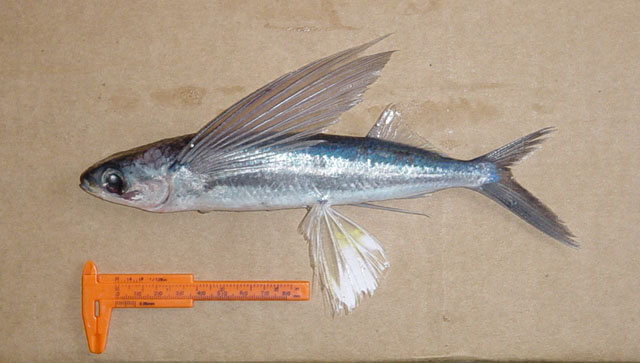| Exocoetidae (Flyingfishes) |
| 33 cm TL (male/unsexed); max. reported age: 1 years |
|
pelagic-neritic; marine; depth range 0 - 100 m, oceanodromous |
| Eastern Atlantic: Guinea to Angola. Western Atlantic: Gulf Stream off Virginia, USA and northern Gulf of Mexico to northern Brazil (Ref. 7251), including the Caribbean Sea (Ref. 3720). Northwest Atlantic: Canada (Ref. 5951). |
|
Dorsal spines (total): 0-0; Dorsal soft rays (total): 11-11; Anal spines: 0-0; Anal soft rays: 11-12. Body elongate, thick, somewhat flattened ventrally; snout shorter than eye, blunt; palatine teeth usually absent; dorsal and anal fins set far back on body, their bases short; dorsal fin low, rays at anterior end the longest; anal fin origin slightly before, or 1 or 2 rays behind dorsal fin origin; pectoral fins strikingly long, 60 to 70 % of SL, only first ray unbranched; pelvic fins large, reaching well beyond anal fin origin; more than 25 scale rows of predorsal scales; dorsally, the color is usually iridescent blue or green in life; dorsal fin colorless or only slightly pigmented; pectoral fins dark, with a pale basal triangle and a narrow white margin (on trailing edge when extended) (Ref. 3720). |
| Occurs in surface waters both near and far from the coast (Ref. 5217). Forms schools. Capable of leaping out and gliding for long distances above the water. Seasonal variation in abundance was noted in the eastern Caribbean countries, a phenomenon that may be due to post-spawning mortality (Ref. 6838). The most important commercial fish species of the eastern Caribbean (Ref. 6504). Considered a good food fish; marketed fresh. |
|
Least Concern (LC); Date assessed: 29 January 2013 Ref. (130435)
|
| harmless |
Source and more info: www.fishbase.org. For personal, classroom, and other internal use only. Not for publication.

